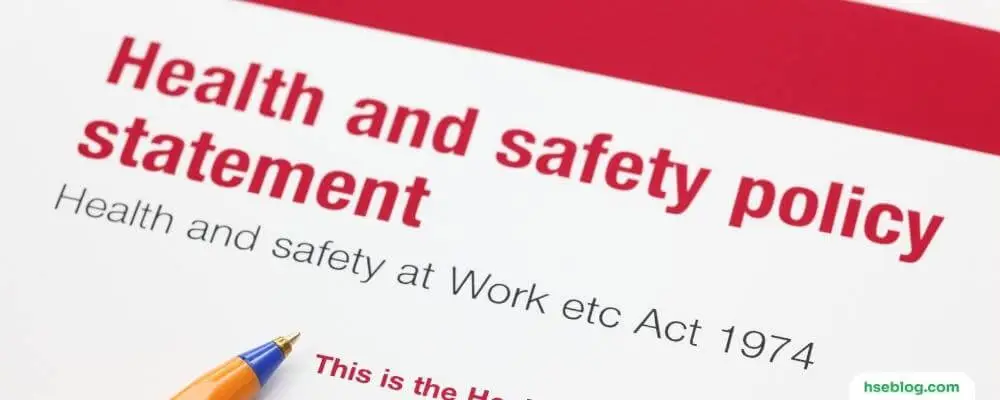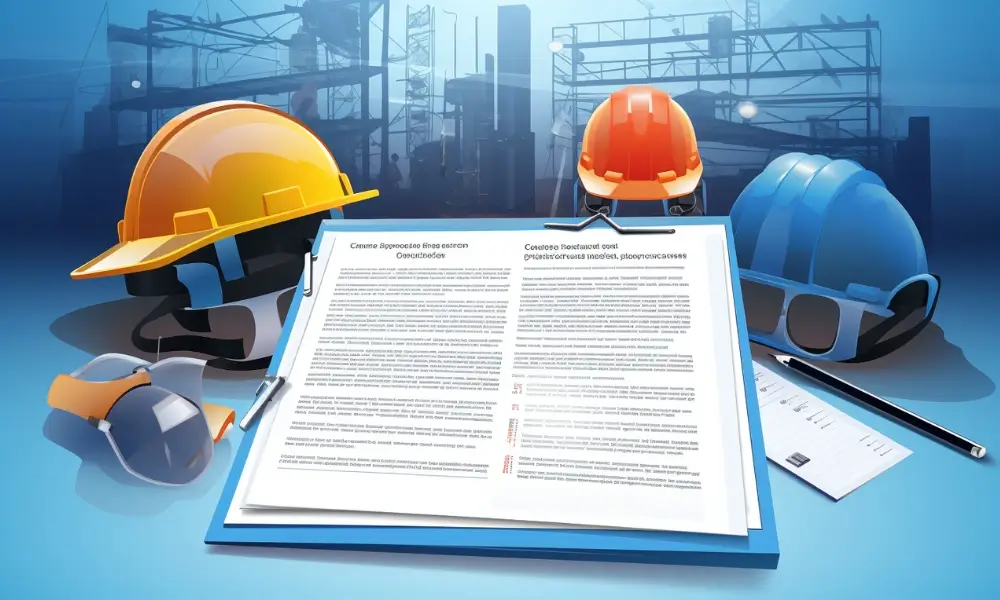Health and safety are paramount considerations in any organization. Protecting the well-being of employees, customers, and stakeholders is a moral obligation and a legal requirement. That’s where a comprehensive health and safety policy comes into play. A health and safety policy is a written statement that outlines an organization’s commitment to maintaining a safe and healthy working environment. It establishes the framework for managing risks, assigns responsibilities, and sets health and safety performance objectives.
This blog will delve into a health and safety policy concept, exploring its significance and the key elements that make it effective. Understanding these elements is crucial for organizations to establish a robust health and safety management system, comply with legal requirements, and foster a safety culture throughout the workplace. So, let’s explore what a health and safety policy entails and the essential components it should encompass.
Health and Safety Policy
A health and safety policy is a written statement that sets out an organization’s commitment to protecting the health and safety of its employees, customers, and other stakeholders. The policy should outline the company’s approach to managing health and safety risks and detail the responsibilities of employees, managers, and other organization members.
An effective health and safety policy should be reviewed and updated regularly to ensure it remains relevant and reflects the organization’s changing needs. The policy should be communicated to all employees and easily accessible so everyone knows their responsibilities.
A health and safety policy is an important part of any organization’s commitment to protecting the health and safety of its employees, customers, and other stakeholders. An effective policy should be reviewed and updated regularly to remain relevant and reflect the organization’s changing needs. The policy should be communicated to all employees and easily accessible so everyone knows their responsibilities.
Every organization should have a clear policy for managing health and safety so that everybody associated with the organization knows its health and safety aims and objectives and how they will be achieved. For a policy to be effective, it must be honored in the spirit and the letter. A good health and safety policy will also enhance the organization’s performance in areas other than health and safety, help the workforce’s personal development, and reduce financial losses.

Health and Safety Policy Legal Requirements
Section 2(3) of the Health and Safety at Work (HSW) Act and the Employers’ Health and Safety Policy Statements (Exception) Regulations 1975 require employers with five or more employees to prepare and regularly review a written health and safety policy together with the necessary organization and arrangements to carry it out and to bring the policy and any revision of it to the notice of their employees.
This does not mean that organizations with four or fewer employees do not need a health and safety policy – it simply means that it does not have to be written down. The number of employees is the maximum, whether full-time, part-time, or seasonal.
This obligation on employers was introduced by the HSW Act and is related to the employer’s reliance on the Act on self-regulation to improve health and safety standards rather than on enforcement alone. A good health and safety policy involves developing, monitoring, and reviewing the standards needed to address and reduce the risks to health and safety produced by the organization.
The law requires that the written health and safety policy should include the following three sections:
- A health and safety policy statement of intent which includes the health and safety aims and objectives of the organization;
- The health and safety organization detailing the people with specific health and safety responsibilities and their duties;
- Health and safety arrangements are in place regarding systems and procedures.
The Management of Health and Safety at Work Regulations also requires the employer to ‘make and give effect to such arrangements as are appropriate, having regard to the nature of their activities and the size of their undertaking, for the effective planning, organization, control, monitoring, and review of the preventative and protective measures. It further requires that these arrangements be recorded when there are five or more employees.
When an inspector from the Health Service Executive (HSE) or Local Authority visits an establishment, they will likely wish to see the health and safety policy as an initial indication of the management attitude and commitment to health and safety. There have been prosecutions due to the absence of a written health and safety policy. (Such cases are usually brought before the courts because of additional concern.)

Key elements of a health and safety policy
A health and safety policy outlines an organization’s commitment to maintaining a safe and healthy work environment for its employees, visitors, and stakeholders. While specific requirements may vary depending on the industry and jurisdiction, here are key elements typically included in a comprehensive health and safety policy:
1. Policy Statement Of Intent
The health and safety policy statement of intent is often referred to as the health and safety policy statement or simply (and incorrectly) as the health and safety policy. It should contain the aims (which are not measurable) and objectives (which are measurable) of the organization or company. Aims will probably remain unchanged during policy revisions, whereas objectives will be reviewed, modified, or changed yearly.
The statement should be written in clear and simple language to be easily understood. It should also be fairly brief and broken down into a series of smaller statements or bullet points. The statement should be signed and dated by the most senior person in the organization. This will demonstrate management’s commitment to health and safety and give Authority to the policy. It will indicate where ultimate responsibility lies and how frequently the policy statement is reviewed.
The most senior manager is normally the Chief Executive Officer (CEO) or the Managing Director. It is the responsibility of the CEO, under the HSW Act, to ensure that the health and safety policy is developed and communicated to all employees in the organization. They will need to ensure the following:
- Key functions of health and safety management, such as monitoring and audit, accident investigation, and training, are included in the organizational structure; adequate resources are available to manage health and safety effectively;
- The production of various health and safety arrangements in terms of rules and procedures;
- Arrangements for the welfare of employees; the regular review and, if necessary, updating of the health and safety policy.
The policy statement should be written by the organization and not external consultants, as it must address the organization’s specific health and safety issues and hazards. In large organizations, it may be necessary to have health and safety policies for each department and/or site, with an overarching general policy incorporating the individual policies. Local authorities and multinational companies often use such an approach.

The following points should be included or considered when a health and safety policy statement is being drafted:
- The aims, which should cover health and safety, welfare, and relevant environmental issues;
- The position of the senior person in the organization or company who is responsible for health and safety (usually the chief executive);
- The names of the Health and Safety Adviser and any safety representatives or other competent health and safety persons;
- A commitment to the basic requirements of the HSW Act (access, egress, risk assessments, safe plant and systems of work, use, handling, transport, and handling of articles and substances, information, training, and supervision);
- A commitment to the additional requirements of the Management of Health and Safety at Work Regulations (risk assessment, emergency procedures, health surveillance, and employment of competent persons);
- Duties towards the wider general public and others (contractors, customers, students, etc.);
- The principal hazards in the organization; specific policies of the organization (e.g., smoking policy, violence to staff, etc.);
- A commitment to employee consultation, possibly using a safety committee or plant council;
- Duties of employees (particularly those defined in the Management of Health and Safety at Work Regulations);
- Specific health and safety performance targets for the immediate and long-term future; a commitment to provide the necessary resources to achieve the objectives outlined in the policy statement.
Health and safety performance targets are an important part of the statement of intent because:
- They indicate that there is management commitment to improve health and safety performance;
- They motivate the workforce with tangible goals resulting in individual or collective rewards;
- They offer evidence during the management system‘s monitoring, review, and audit phases.
The type of target chosen depends very much on the areas that need the organization’s greatest improvement. The following list, which is not exhaustive, shows common health and safety performance targets:
- A specific reduction in the number of accidents,
- Incidents (not involving injury) and cases of work-related ill-health (perhaps to zero);
- A reduction in the level of sickness absence;
- A specific increase in the number of employees trained in health and safety;
- An increase in the reporting of minor accidents and ‘near miss’ incidents;
- A reduction in the number of civil claims;
- No enforcement notices from the HSE or Local Authority;
- A specific improvement in health and safety audit scores;
- The achievement of a nationally recognized health and safety management standard such as OHSAS 18001
The policy statement of intent should be posted on prominent notice boards throughout the workplace and brought to the attention of all employees at induction and refresher training sessions. It can also be communicated to the workforce during team briefing sessions, at ‘toolbox’ talks conducted at the workplace, or by email, intranet, newsletters, or booklets. It should be a permanent item on the agenda for health and safety committee meetings, where it and its related targets should be reviewed at each meeting.

2. Organization Of Health And Safety
This policy section defines the names, positions, and duties of those within the organization or company with specific responsibility for health and safety. Therefore, it identifies those health and safety responsibilities and the reporting lines through the management structure. This section will include the following groups together with their associated responsibilities:
- Directors and senior managers (responsible for setting policy, objectives, and targets);
- Supervisors (responsible for checking day-to-day compliance with the policy);
- Health and safety advisers (responsible for giving advice during accident investigations and on compliance issues);
- Other specialists, such as an occupational nurse, chemical analyst, and an electrician (responsible for giving specialist advice on particular health and safety issues);
- Health and safety representatives (responsible for representing employees during consultation meetings on health and safety issues with the employer);
- Employees (responsible for taking reasonable care of the health and safety of themselves and others who may be affected by their acts or omissions);
- Fire marshals (responsible for the safe evacuation of the building in an emergency);
- First aiders (responsible for administering first aid to injured persons).
Some of the specialists mentioned above may be employed on a consultancy basis for smaller organizations. For the health and safety organization to work successfully, it must be supported from the top (preferably at the Board level) and some financial resources made available.
It is also important that certain key functions are included in the organization’s structure. These include:
- Accident investigation and reporting;
- Health and safety training and information;
- Health and safety monitoring and audit;
- Health surveillance;
- Monitoring of plant and equipment, their maintenance, and risk assessment;
- Liaison with external agencies, management, and/or employee safety committees – the management committee will monitor day-to-day problems and any employee health and safety committee concerns.
The role of the health and safety adviser is to provide specialist information to managers in the organization and to monitor the effectiveness of health and safety. Procedures. The adviser is not ‘responsible’ for health and safety or its implementation; that is the role of the line managers.
Finally, the job descriptions, which define the duties of each person in the health and safety organizational structure, must not contain responsibility overlaps or blur chains of command. Each individual must be clear about his/her responsibilities and the limits of those responsibilities.

3. Arrangements For Health And Safety
The arrangements section of the health and safety policy gives details of the specific systems and procedures used to assist in implementing the policy statement. This will include health and safety rules and procedures and providing facilities such as first-aid room and washrooms. It is common for risk assessments (including COSHH, manual handling, and personal protective equipment (PPE) assessments) to be included in the arrangements section, particularly for those hazards referred to in the policy statement. Arrangements for fire and other emergencies and for information, instruction, training, and supervision must also be covered. Local codes of practice (e.g., for forklift truck drivers) should be included.
The following list covers the more common items normally included in the arrangements section of the health and safety policy:
- Employee health and safety code of practice;
- Accident and illness reporting and investigation procedures; emergency procedures, first aid;
- fire-drill procedure; procedures for undertaking risk assessments; control of exposure to specific hazards (noise, vibration, radiation, manual handling, hazardous substances, etc.);
- Machinery safety (including safe systems of work, lifting, and pressure equipment);
- Electrical equipment (maintenance and testing);
- Maintenance procedures; permits to work procedures; use of PPE;
- Monitoring procedures, including health and safety inspections and audits;
- Procedures for the control and safety of contractors and visitors; provision of welfare facilities;
- Training procedures and arrangements; catering and food hygiene procedures;
- Arrangements for consultation with employees;
- Terms of reference and constitution of the safety committee; procedures and arrangements for waste disposal.

4. Review Of Health And Safety Policy
The health and safety policy must be monitored and reviewed regularly. A series of benchmarks need to be established for this to be successful. Such benchmarks, or examples of good practice, are defined by comparison with the health and safety performance of other parts of the organization or the national performance of the occupational group of the organization. The HSE publishes an annual report, statistics, and a bulletin, all of which may be used for this purpose. Typical benchmarks include accident rates per employee and accident or disease causation.
There are several reasons to review the health and safety policy. The more important reasons are:
- Significant organizational changes may have taken place;
- There have been changes in key personnel;
- There have been changes in legislation and/or guidance;
- New work methods have been introduced;
- There have been alterations to working arrangements and/or processes. There have been changes following consultation with employees;
- The monitoring of risk assessments or accident/incident investigations indicates that the health and safety policy is no longer totally effective;
- Information from manufacturers has been received;
- Advice from an insurance company has been received;
- The findings of an external health and safety audit; enforcement action has been taken by the HSE or Local Authority;
- A sufficient period of time has elapsed since the previous review.
Positive health and safety performance promotion will achieve far more than simply preventing accidents and ill health. It will:
- Support the overall development of personnel;
- Improve communication and consultation throughout the organization;
- Minimize financial losses due to accidents and ill health, and other incidents;
- Directly involve senior managers in all levels of the organization;
- Improve supervision, particularly for young persons and those on occupational training courses;
- Improve production processes;
- Improve the public image of the organization or company.
It is apparent, however, that some health and safety policies appear to be less than successful. There are many reasons for this. The most common are:
- The statements in the policy and the health and safety priorities are not understood by or properly communicated to the workforce;
- Minimal resources made available for the implementation of the policy;
- Too much emphasis on rules for employees and too little on management policy;
- A lack of parity with other activities of the organization (such as finance and quality control) due to mistaken concerns about the costs of health and safety and the effect of those costs on overall performance. This attitude produces a poor health and safety culture;
- Lack of senior management involvement in health and safety, particularly at the board level;
- Employees are concerned that their health and safety issues are not being addressed or receiving adequate health and safety information. This can lead to low morale among the workforce and, possibly, high absenteeism, high labor turnover;
- Inadequate or no PPE;
- Unsafe and poorly maintained machinery and equipment;
- A lack of health and safety monitoring procedures.
A successful health and safety policy will likely lead to a successful organization or company.

Health And Safety Policy Checklist
The following checklist is intended to aid the writing and review of a health and safety policy. It is derived from HSE Information.
General policy and organization
- Does the statement express a commitment to health and safety, and are your obligations towards your employees made clear?
- Does it say which senior manager is responsible for implementing it and keeping it under review, and how will this be done?
- Is it signed and dated by you or a partner or senior director?
- Have the views of managers and supervisors, safety representatives, and the safety committee been considered?
- Were the duties set out in the statement discussed with the people concerned and accepted by them, and do they understand how their performance will be assessed and what resources they have at their disposal?
- Does the statement make clear that cooperation on the part of all employees is vital to the success of your health and safety policy?
- Does it say how employees are to be involved in health and safety matters, for example, by being consulted, taking part in inspections, and sitting on a safety committee?
- Does it show clearly how the duties for health and safety are allocated, and are the responsibilities at different levels described?
- Does it say who is responsible for the following matters (including deputies where appropriate)? Reporting investigations and recording accidents; fire precautions; fire drill and evacuation procedures; first aid; safety inspections; the training program; ensuring that legal requirements are met, for example, regular testing of lifts and notifying accidents to the health and safety inspector.
Arrangements that need to be considered
- Keeping the workplace, including staircases, floors, ways in and out, washrooms, etc., in a safe and clean condition by cleaning, maintenance, and repair;
- The requirements of the Work at Height Regulations;
- Any suitable and sufficient risk assessments.
Plant and substances
- Maintenance of equipment such as tools, ladders, etc. (are they in a safe condition?);
- Maintenance and proper use of safety equipment such as helmets, boots, goggles, respirators, etc.;
- Maintenance and proper use of plant, machinery, and guards; regular testing and
- Maintenance of lifts, hoists, cranes, pressure systems, boilers, and other dangerous machinery, emergency repair work, and safe methods of carrying out these functions;
- Maintenance of electrical installations and equipment;
- Safe storage, handling, and, where applicable, packaging, labeling, and transport of flammable and/or hazardous substances;
- Controls of work involving harmful substances such as lead and asbestos;
- The introduction of the new plant, equipment, or substances into the workplace by examination, testing, and consultation with the workforce;
- Exposure to non-ionizing and ionizing radiation.
Other hazards
- Noise problems – wearing of hearing protection and control of noise at source;
- Vibration problems – hand-arm and whole-body control techniques and personal protection;
- Preventing unnecessary or unauthorized entry into hazardous areas; lifting of heavy or awkward loads;
- Protecting the safety of employees against assault when handling or transporting the employer’s money or valuables;
- Special hazards to employees when working on unfamiliar sites, including discussion with site manager where necessary;
- Control of works transport, for example, fork-lift trucks, by restricting use to experienced and authorized operators or operators under instruction (which should deal fully with safety aspects)—driving on public roads while at work.

Emergencies
- Ensuring that fire exits are marked, unlocked, and free from obstruction;
- Maintenance and testing of fire-fighting equipment, fire drills, and evacuation procedures;
- First aid, including name and location of the person responsible for first aid and deputy, and location of the first-aid box.
Communication
- Giving employees information about the general duties under the HSW Act and specific legal requirements relating to their work;
- Giving employees necessary information about substances, plants, machinery, and equipment with which they come into contact;
- Discussing with contractors, before they come on-site, how they plan to do their job, whether they need any equipment from your organization to help them, whether they can operate in a segregated area or only when part of the plant is shut down, and, if not, what hazards they may create for your employees and vice versa.
Training
- Training employees, supervisors, and managers enable them to work safely and carry out their health and safety responsibilities efficiently.
Supervising
- Supervise employees as necessary for their safety – especially young workers, new employees, and employees carrying out unfamiliar tasks.
Keeping check
- Regularly inspect the workplace, machinery appliances, and working methods.
Conclusion
In conclusion, a health and safety policy is a vital document that demonstrates an organization’s commitment to protecting the well-being of its workforce and stakeholders. It is a roadmap for managing health and safety risks, outlining responsibilities, and setting objectives. The key elements of a comprehensive policy include a clear statement of intent, an organized structure for health and safety responsibilities, and well-defined arrangements for implementing procedures and controls.
Regular review and updating of the policy ensure its continued relevance and effectiveness. Organizations can create a safe and healthy work environment by prioritizing health and safety through a well-crafted policy while enhancing overall performance and minimizing potential risks.

